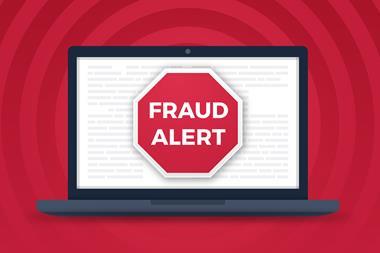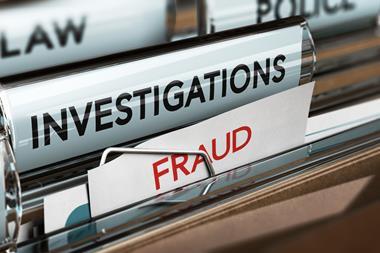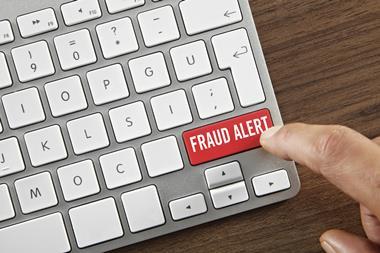Insurers are ‘shocked’ by the level of commercial linked fraud they are uncovering, says law firm partner
By Katie Scott

What is the image that comes to mind when I say ‘insurance fraud’?
For many, insurance fraud is typically within the world of personal lines, with potential policyholders using their creative licence on policy applications, home or personal injury claims being fabricated or exaggerated, or fraudsters conducting crash for cash scams.
As industry conversations around ghost broking increase – in large part thanks to the work of the City of London Police’s Insurance Fraud Enforcement Department – the picture of insurance fraud may even include fake policies being sold via social media.
However, one area where fraud is rampant yet remains largely undiscussed by sector commentators is around commercial entities.
This activity is occupying a lot of Paul Holmes’ time in his role as partner at global law firm DWF Law. So much of his case work is revolving around fraud concerning commercial entities that he reached out to talk me through the current scenarios he is seeing coming across his desk.
Our conversation was a real eye-opener, so here’s my roundup of what commercial insurers and brokers need to be watching for in terms of developing fraud threats.
Types of fraud
According to Holmes, the majority of fraud in the commercial arena is centred around the incorporation of fake businesses.
Read: Briefing - Commercial brokers are ‘very naïve’ about insurance fraud
Read: Briefing - How has Ifed evolved its approach to online ghost brokers?
Explore more fraud-related content here, or discover more briefing articles here
One motivation for doing this would be to enable those who are unable to take out a commercial insurance policy to do so.
Holmes explained: “[Fraudsters] are masking who is running the company in order to incept a policy fraudulently. So that’s typically insolvent directors, people who have run strings of companies that have gone under, people with criminal records.
“They are installing, if you like, shadow directors into the companies to run them. That’s one type of commercial fraud.”
Fake companies are also created to facilitate “fraudulent claims”, “fraudulently trade” and “money laundering outfits”, Holmes added.
In these circumstances, the fake organisation may state a particular business type or operation on their documentation, when really, they don’t conduct this activity at all and often don’t even have a premise from which to perform these operations.
“You’ve got companies incorporating, for example, a plant company to then say that the plant has been stolen and it’s a fraudulent claim,” Holmes explained.
“You’ll get a commercial motor policy, fleet policy being incorporated [so that a theft claim can be made], or to potentially ghost broke [too].”
Holmes has seen examples where companies have “just been incorporated to literally set up a fraudulent claim from the very beginning”.
The other side of the commercial fraud coin is when genuine businesses lie. These cases will typically be “linked to organised crime”, Holmes noted. The “real business is criminal and it’s just a front,” he said.
Legitimate companies may also seek to pull the wool over insurers’ eyes “about their area of business”, instead claiming to have “a lower risk of business” in order to nab cheaper premiums.
There is additionally the chance that genuine companies could have their identities stolen by criminals – this identity theft is then used to insure vehicles for drug running, for example, to prevent the vehicles being stopped by police.
Hiding in plain sight
A key challenge with this type of fraud, according to Holmes, is determining a legitimate business versus a fraudulent one.
Read: Opinion - Personal motor market continues to be messy
Read: Tackling opportunistic fraud requires ‘a measured approach’
Explore more fraud-related content here, or discover more news analysis here
Holmes despaired that it is far too easy for a business to get visibility on Companies House – an executive agency of the Department for Business and Trade – when in reality, a page on its UK register of companies is fairly simple to achieve.
He told me: “One of the problems we face is that because the companies are on Companies House, it gives legitimacy to that entity when, in fact, it’s very simple. For £10, you can incorporate the company online, within hours.
“Therefore, what happens is if anyone decides to check, [such as underwriters or brokers], the company’s there and it almost lures people into a false sense of security. You might even look at their accounts that can be totally fictitious.
“This isn’t just a single, rare problem. These aren’t small frauds unfortunately. So, it’s a major issue.”
Problem solving?
With the Official Injury Claim portal ticking along and taking care of previously voluminous whiplash claims, Holmes believes that insurers now have more time on their hands to review other types of fraud.
“Because of declining whiplash claims, insurers have broadened their net to look at other types of fraud. They are quite shocked in terms of what they find out,” he said.
But how is the insurance industry meant to tackle this rising fraud threat?
Detection is obviously paramount and although this is often aided by data and technology, underpinning any fraud detection scheme should be education. Counter fraud professionals must be brought up to speed on what to look for and what inconsistencies could be linked to fraudulent activity in the commercial arena.
Increasingly, the feedback I am hearing is that commercial lines focused brokers are simply unaware of the fraud challenges coming down the line – this must be addressed as brokers can act as the first line of defence, helping to protect genuine policyholders.

Since joining Insurance Times, Katie has successfully obtained a number of industry accolades. Most recently, at Biba's 2025 Journalist and Media Awards, Katie was named the overall winner and received the Journalist of the Year trophy, alongside the Best Thought Leadership Award for her briefing article on reproductive health MGA Juniper and how insurance can be used to positively impact taboo subjects.View full Profile
Hosted by comedian and actor Tom Allen, 34 Gold, 23 Silver and 22 Bronze awards were handed out across an amazing 34 categories recognising brilliance and innovation right across the breadth of UK general insurance.
























































No comments yet